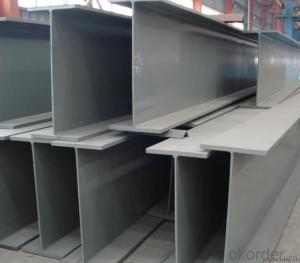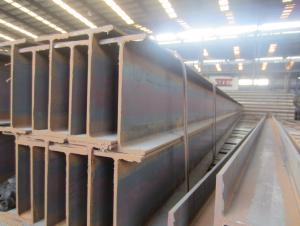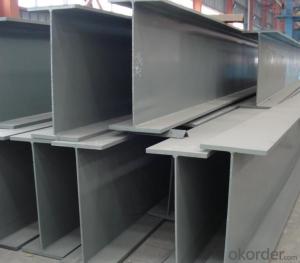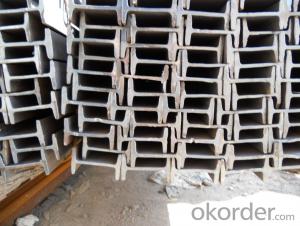Japanese Standard SS400 H beam with High Quality 300mm-350mm
- Loading Port:
- China main port
- Payment Terms:
- TT or LC
- Min Order Qty:
- 100 m.t
- Supply Capability:
- 15000 m.t/month
OKorder Service Pledge
OKorder Financial Service
You Might Also Like
Specifications of Japanese Standard SS400 H beam with High Quality 300mm-350mm:
1. Standard: JIS 3192
2. Grade: SS400 or Equivalent
3. Length: 10m, 12m as following table
4. Invoicing on theoretical weight or actual weight as customer request
5.Payment: TT or L/C
Size and Mass of Japanese Standard SS400 H beam with High Quality 300mm-350mm:
| Size (mm) | Mass (Kg/m) | Size (mm) | Mass (Kg) |
| 300*300*10.0 | 93.0 | 346*174*6.0 | 41.2 |
| 300*305*15.0 | 105 | 350*175*7.0 | 49.4 |
Packaging & Delivery of Japanese Standard SS400 H beam with High Quality 300mm-350mm for Building Structures:
1. Packing: it is nude packed in bundles by steel wire rod
2. Bundle weight: not more than 3.5MT for bulk vessel; less than 3 MT for container load
3. Marks:
Color marking: There will be color marking on both end of the bundle for the cargo delivered by bulk vessel. That makes it easily to distinguish at the destination port.
Tag mark: there will be tag mark tied up on the bundles. The information usually including supplier logo and name, product name, made in China, shipping marks and other information request by the customer.
If loading by container the marking is not needed, but we will prepare it as customer request.
4. Transportation: the goods are delivered by truck from mill to loading port, the maximum quantity can be loaded is around 40MTs by each truck. If the order quantity cannot reach the full truck loaded, the transportation cost per ton will be little higher than full load.
5. Delivered by container or bulk vessel
FAQ:
Q1: Why buy Materials & Equipment from OKorder.com?
A1: All products offered by OKorder.com are carefully selected from China's most reliable manufacturing enterprises. Through its ISO certifications, OKorder.com adheres to the highest standards and a commitment to supply chain safety and customer satisfaction.
Q2: How do we guarantee the quality of our products?
A2: We have established an advanced quality management system which conducts strict quality tests at every step, from raw materials to the final product. At the same time, we provide extensive follow-up service assurances as required.
Q3: How soon can we receive the product after purchase?
A3: Within three days of placing an order, we will arrange production. The shipping date is dependent upon the quatity, how many sizes you want and the plan of production, but is typically 1 month to 2 months days from the beginning of production.
Images of Japanese Standard SS400 H beam with High Quality 300mm-350mm:
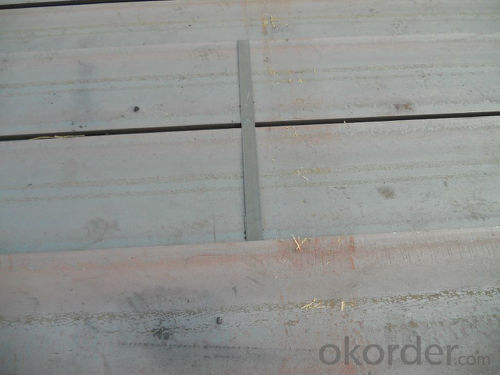
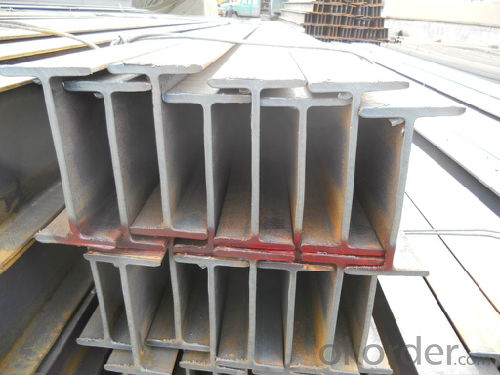
* If you would like to get our price, please inform us the size, standard/material and quantity. Thank you very much for your attention.
- Q:Can steel H-beams be used for bridge construction?
- Indeed, steel H-beams are applicable for bridge construction purposes. Known interchangeably as I-beams or W-beams, these steel H-beams are frequently employed in bridge construction due to their remarkable strength and capacity to bear loads. Offering exceptional structural support, H-beams are capable of enduring substantial weights, rendering them well-suited for bridges necessitating support for both vehicular and pedestrian traffic. Furthermore, steel H-beams possess durability, resistance to corrosion, and effortless fabrication and installation, thereby solidifying their status as a favored option in bridge construction ventures.
- Q:Are steel H-beams resistant to chemical exposure or spills?
- Steel H-beams are generally resistant to chemical exposure or spills. Steel is known for its durability and strength, making it less susceptible to damage from chemical substances. However, the specific level of resistance depends on the type and concentration of the chemical involved. While steel is generally resistant to most chemicals, highly corrosive substances or prolonged exposure to certain chemicals may eventually cause deterioration and compromise the structural integrity of the H-beams. Therefore, it is essential to consider the specific chemical environment and consult with experts or manufacturers to ensure the appropriate grade of steel is chosen for the intended application. Additionally, proper maintenance and regular inspections are crucial to identify any signs of corrosion or damage caused by chemical exposure and take appropriate measures to mitigate potential risks.
- Q:Can steel H-beams be used in airport hangar construction?
- Indeed, airport hangar construction can involve the utilization of steel H-beams. These beams are widely employed in the construction industry due to their remarkable strength, durability, and versatility. They possess the ability to withstand substantial loads and offer exceptional support for extensive structures such as airport hangars. The unique H shape of these beams enhances their strength and stability, rendering them well-suited for the construction of vast buildings like hangars. Moreover, steel is the preferred material for hangar construction owing to its resistance to fire, pests, and rot, which ensures the safety and longevity of the structure. Consequently, steel H-beams prove to be a fitting choice for airport hangar construction.
- Q:How do steel H-beams perform in extreme weather conditions such as hurricanes or cyclones?
- Steel H-beams are known for their exceptional strength and durability, making them a popular choice for various construction applications, including in areas prone to extreme weather conditions like hurricanes or cyclones. When it comes to withstanding the forces exerted by such weather events, steel H-beams have proven to be highly reliable. The unique structural design of H-beams, with their flanges and web, allows them to distribute loads evenly along their length, making them resistant to bending or buckling. This structural integrity enables H-beams to withstand the strong winds and forces generated by hurricanes or cyclones. In extreme weather conditions, such as hurricanes, the wind speed can reach incredibly high velocities. The aerodynamic design of H-beams, with their streamlined shape and minimal surface area, helps reduce wind resistance. This significantly decreases the chances of the beams being blown away or damaged during the storm. Additionally, steel H-beams have excellent corrosion resistance properties. They are often galvanized or coated with protective coatings, which prevent rust or deterioration caused by moisture, a common occurrence during hurricanes or cyclones. This ensures that the structural integrity of the beams remains intact even after prolonged exposure to extreme weather conditions. Moreover, steel H-beams possess a high load-bearing capacity, allowing them to support heavy loads such as roofs, walls, or floors. This strength is particularly crucial during hurricanes or cyclones, where the beams must withstand not only the wind forces but also the weight of debris or falling objects. Overall, steel H-beams are engineered to perform exceptionally well in extreme weather conditions such as hurricanes or cyclones. Their strength, durability, resistance to bending and buckling, corrosion resistance, and high load-bearing capacity make them a reliable choice for construction in areas prone to such weather events.
- Q:What are the uses of I-beam and H steel?
- HW HM HN H is a general term for H steel, H is welded, and HW HM HN is hot rolledHW is a H type steel flange height and width substantially equal; mainly used for reinforced concrete frame column steel column, also known as rigid steel column; column is mainly used in steel structure
- Q:Are steel H-beams suitable for use in the construction of sports facilities?
- Yes, steel H-beams are suitable for use in the construction of sports facilities. Steel H-beams are commonly used in construction due to their strength, durability, and versatility. They can withstand heavy loads, making them ideal for supporting large structures such as sports arenas, stadiums, and gymnasiums. Additionally, H-beams provide excellent structural integrity, ensuring the safety and stability of the sports facility. Moreover, steel H-beams can be easily fabricated and installed, allowing for efficient construction and reduced construction time. Overall, steel H-beams are a reliable and cost-effective choice for the construction of sports facilities, meeting the specific requirements and demands of these structures.
- Q:What are the different design codes for steel H-beams?
- Structural engineering utilizes diverse design codes to regulate the utilization of steel H-beams. Notable design codes for steel H-beams encompass: 1. American Institute of Steel Construction (AISC) - AISC furnishes design guidelines and specifications tailored to steel H-beams in the United States. The primary design code employed for steel H-beams in the US is the AISC 360 "Specification for Structural Steel Buildings." It encompasses various elements such as design principles, load combinations, structural detailing, and material properties. 2. Eurocode - Eurocode constitutes a compilation of European standards for structural design. Eurocode 3, otherwise known as EN 1993, delivers design rules for steel structures, including H-beams. It covers domains like material properties, cross-section classification, member design, and fire resistance. 3. British Standards (BS) - The British Standards Institution (BSI) has fashioned numerous design codes for steel H-beams, such as BS 5950-1 for the structural use of steelwork in buildings and BS EN 1993-1-1 for general structural design. 4. Canadian Standards Association (CSA) - In Canada, the primary design code employed for steel H-beams is CSA S16. This code imparts design principles, material specifications, and construction requisites for steel structures. 5. Australian Standards (AS) - AS 4100 governs the design of steel H-beams in Australia. It provides guidelines for structural design using steel. 6. International Building Code (IBC) - The IBC represents a prominently adopted building code within the United States. It references several design codes, including AISC 360, for the design of steel structures, encompassing H-beams. These aforementioned instances represent a fraction of the international design codes employed for steel H-beams. It is imperative for engineers and designers to adhere to the applicable code pertinent to their region or project to ensure the secure and efficient design of steel H-beams.
- Q:Can steel H-beams be used in mezzanine or elevated flooring systems?
- Yes, steel H-beams can be used in mezzanine or elevated flooring systems. Steel H-beams provide strong structural support and are commonly used in construction for their durability and load-bearing capabilities. They are suitable for creating stable and secure elevated platforms such as mezzanines or flooring systems.
- Q:Can steel H-beams be used in theater or stage construction?
- Certainly! Theater and stage construction can indeed utilize steel H-beams. These beams possess remarkable strength and durability, offering structural support for a wide range of construction purposes, including theater and stage design. H-beams commonly serve as the framework for stages, platforms, and rigging systems, ensuring stability and support for different components of a stage or theater set. Moreover, steel H-beams can be easily tailored and adjusted to fit the precise requirements and dimensions of theater or stage designs, thus exhibiting versatility for construction within the entertainment industry.
- Q:Are steel H-beams resistant to sound or noise transmission?
- Sound or noise transmission is not inherently resisted by steel H-beams. However, if steel H-beams are adequately insulated or treated with soundproofing materials, they can effectively reduce noise transmission. Due to its density, steel has the potential to easily transmit sound waves, necessitating further measures to minimize noise transmission through steel H-beams. This can be accomplished by incorporating insulation materials like rubber, foam, or other sound-absorbing materials into the beams. These materials aid in absorbing and dampening sound vibrations, thus decreasing the amount of noise that penetrates the beams. Additionally, employing proper construction techniques and design considerations, such as constructing double walls or utilizing resilient channels, can also help mitigate sound transmission through steel H-beams. Ultimately, the effectiveness of steel H-beams in resisting sound or noise transmission relies on the specific construction methods and materials used in conjunction with the beams.
1. Manufacturer Overview |
|
|---|---|
| Location | |
| Year Established | |
| Annual Output Value | |
| Main Markets | |
| Company Certifications | |
2. Manufacturer Certificates |
|
|---|---|
| a) Certification Name | |
| Range | |
| Reference | |
| Validity Period | |
3. Manufacturer Capability |
|
|---|---|
| a)Trade Capacity | |
| Nearest Port | |
| Export Percentage | |
| No.of Employees in Trade Department | |
| Language Spoken: | |
| b)Factory Information | |
| Factory Size: | |
| No. of Production Lines | |
| Contract Manufacturing | |
| Product Price Range | |
Send your message to us
Japanese Standard SS400 H beam with High Quality 300mm-350mm
- Loading Port:
- China main port
- Payment Terms:
- TT or LC
- Min Order Qty:
- 100 m.t
- Supply Capability:
- 15000 m.t/month
OKorder Service Pledge
OKorder Financial Service
Similar products
New products
Hot products
Related keywords





















